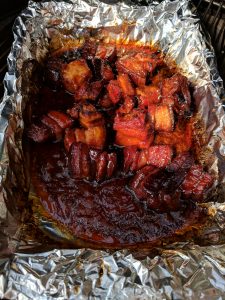Labor Day holiday weekend ended a five-day fast, followed by another 2 weeks of unrepentant feasting, with a couple days of fasting scattered in between. During this time, I spent a lot of hours in the kitchen testing recipes. If you’ve been on my Instagram feed, you’ve seen the outcomes of two weekends’ worth of BBQ: smoked “American” Wagyu brisket, pork belly burnt ends, and BBQ pork ribs (St Louis cut from Matador Meat & Wine and Back Loin from Kroger’s in-house brand). Not to mention the prime (Matador) and A-wagyu (A Bar N) ribeyes we grilled up in the intervening period.
Of course, the add-ons to these main dishes are generally what makes an entire meal complete and wholly satisfying. In my household, it’s usually some vegetable side dish (brussel sprouts, broccoli and cauliflower are the main draws). When we’re craving carbs, it’ll be some grain-based or starchy side dish (think corn, pasta or potato).
Personally, my fave accompaniment to any beef cut is a couple of raw sliced red onions. It helps lessens the intense fattiness of some cuts (roasted beef ribs and prime rib) while enhancing the beefy flavor of a well-graded cut. It’s my only “required” vegetable topping on a medium-rare burger–hold the lettuce and tomato please!
Alas, raw onion consumption isn’t recommended for post-dinner social or romantic encounters…it’s the resultant onion breath and digestive mishaps that cause many to avoid the raw version altogether. If it’s at all included in a dish, onions often always get cooked past recognition–stripped exclusively for flavoring–if not discarded entirely.
Let’s not forget the discomfort that comes with preparing onions either, pungent smells and eye tearing tend to be the biggest reasons why the onion goes underutilized in kitchens. Not to mention the possible emergency room visit when an unskilled knife is applied to an irregularly globed surface.
I can rant on about onions in general, but let’s focus on the purpose of this post: which is about my pursuit of the tastiest fried onion recipe.
The fried onion gets no love it seems. It’s rarely offered on or ordered from restaurant menus when it competes with other fried vegetables, most popular of which is the potato fry. There’s only one dish that immediately comes to mind when fried onions are involved and it’s the green bean casserole dish–an ubiquitous entry on many a Thanksgiving dinner menu. Frequently, the fried onions adorning the dish came already commercially pre-cooked, dispensed from a can. Or, even faked–think Funyuns!
My love of fried onions has me seeking out restaurants, sampling various cuisines, and testing myriad recipes looking for a favorite, and I’ve eaten enough of them to know they generally fall into 2 camps: battered or breaded. Then they’ll appear in one of 2 forms: rings or strings. Of consideration is the type of onion used, normally yellow or white.
The problems I’ve had with nearly every fried onion I’ve eaten are the tastes and textures. Oftentimes the onion flavor disappears and you end up eating a mouthful of doughy batter and tasteless breading. When it’s not overwhelmed by the coating, the onion itself tends to be devoid of pungent sharpness due largely to the market’s preferences for mild, sweet onions: less sulfur and mellow cultivars!
As you may know by now, my food preference skews towards the bold and the strong. An onion should have bite: sharp, pungent, stinging without brutally assaulting the senses (though I’d argue that the freshest, bestest eating onion should make you cry). I’d like the flavor to be a touch sweet, which is why I enjoy red onions most of all, striking a balance between pungent and sweet. Then there’s the shallot…well that’s all I gotta say about that.
For this experiment, we are starting with tapioca flour (or starch) as the coating. I’ve had very good success with shallow frying tapioca flour, which produces a crisp exterior. How it’s applied is via a 2-step method: egg wash then dredge. Then the onion rings are deep fried in peanut oil between 350F to 375F.

The result is a crispy onion ring, if a little bland. I prefer to toss them in a stainless steel bowl and season them with a little salt and pepper. I also tried sprinkling parmesan over a small batch (anybody remember JT Mccords)…delish!
Stay tuned for my next fried onion experiment to take a stab at a different flour/coating.









